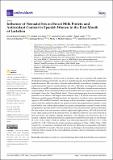Por favor, use este identificador para citar o enlazar a este item:
http://hdl.handle.net/10261/302996COMPARTIR / EXPORTAR:
 SHARE SHARE
 CORE
BASE CORE
BASE
|
|
| Visualizar otros formatos: MARC | Dublin Core | RDF | ORE | MODS | METS | DIDL | DATACITE | |

| Título: | Influence of neonatal sex on breast milk protein and antioxidant content in Spanish women in the first month of lactation |
Autor: | Ramiro-Cortijo, David; Gila-Diaz, Andrea; Herranz Carrillo, Gloria; Cañas, Silvia CSIC ORCID; Gil-Ramírez, Alicia CSIC ORCID; Ruvira, Santiago; Martín-Cabrejas, María A. CSIC ORCID ; Arribas, Silvia M. | Palabras clave: | Antioxidants Macronutrients Neonatal sex Breastfeeding Male disadvantage Breast milk |
Fecha de publicación: | 2022 | Editor: | Multidisciplinary Digital Publishing Institute | Citación: | Antioxidants 11(8): 1472 (2022) | Resumen: | Breast milk (BM) is the best food for newborns. Male sex is associated with a higher risk of fetal programming, prematurity, and adverse postnatal outcome, being that BM is an important health determinant. BM composition is dynamic and modified by several factors, including lactation period, prematurity, maternal nutritional status, and others. This study was designed to evaluate the influence of sex on BM composition during the first month of lactation, focused on macronutrients and antioxidants. Forty-eight breastfeeding women and their fifty-five newborns were recruited at the Hospital Clínico San Carlos (Madrid, Spain). Clinical sociodemographic data and anthropometric parameters were collected. BM samples were obtained at days 7, 14, and 28 of lactation to assess fat (Mojonnier method), protein (Bradford method), and biomarkers of oxidative status: total antioxidant capacity (ABTS and FRAP methods), thiol groups, reduced glutathione, superoxide dismutase and catalase activities, lipid peroxidation, and protein oxidation (spectrophotometric methods). Linear mixed models with random effects adjusted by maternal anthropometry, neonatal Z-scores at birth, and gestational age were used to assess the main effects of sex, lactation period, and their interaction. BM from mothers with male neonates exhibited significantly higher protein, ABTS, FRAP, and GSH levels, while catalase showed the opposite trend. No differences between sexes were observed in SOD, total thiols, and oxidative damage biomarkers. Most changes were observed on day 7 of lactation. Adjusted models demonstrated a significant association between male sex and proteins (β = 2.70 ± 1.20; p-Value = 0.048). In addition, total antioxidant capacity by ABTS (β = 0.11 ± 0.06) and GSH (β = 1.82 ± 0.94) showed a positive trend near significance (p-Value = 0.056; p-Value = 0.064, respectively). In conclusion, transitional milk showed sex differences in composition with higher protein and GSH levels in males. This may represent an advantage in the immediate perinatal period, which may help to counteract the worse adaptation of males to adverse intrauterine environments and prematurity. | Descripción: | This article belongs to the Special Issue Oxidative Stress, Pregnancy and Pregnancy-Related Diseases. | Versión del editor: | https://doi.org/10.3390/antiox11081472 | URI: | http://hdl.handle.net/10261/302996 | DOI: | 10.3390/antiox11081472 | E-ISSN: | 2076-3921 |
| Aparece en las colecciones: | (CIAL) Artículos |
Ficheros en este ítem:
| Fichero | Descripción | Tamaño | Formato | |
|---|---|---|---|---|
| influenlacta.pdf | 1,75 MB | Adobe PDF |  Visualizar/Abrir |
CORE Recommender
PubMed Central
Citations
2
checked on 21-abr-2024
SCOPUSTM
Citations
2
checked on 25-abr-2024
WEB OF SCIENCETM
Citations
2
checked on 27-feb-2024
Page view(s)
48
checked on 27-abr-2024
Download(s)
314
checked on 27-abr-2024

